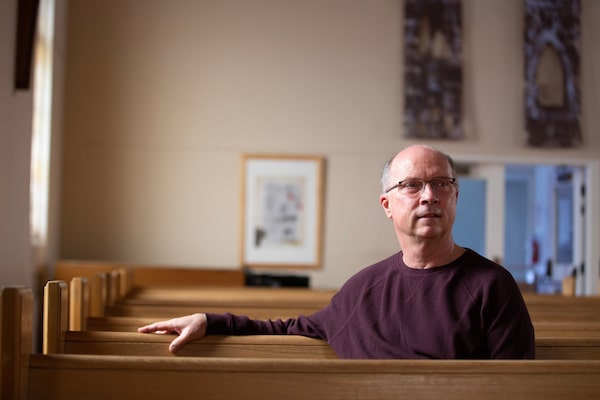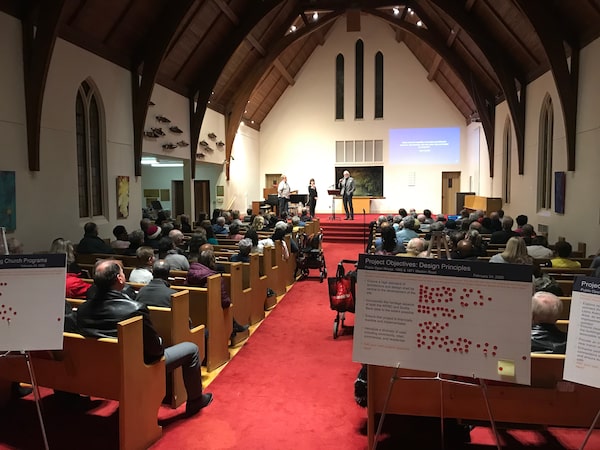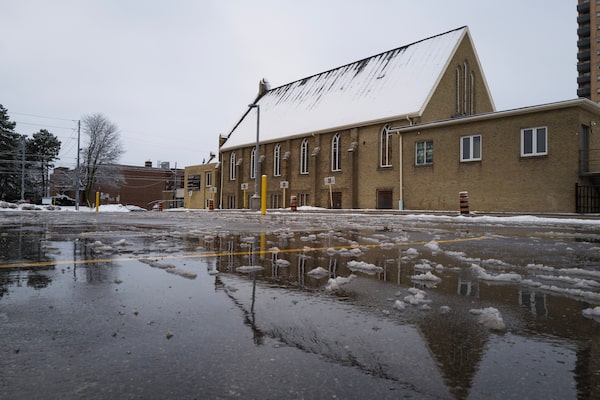
John Frogley-Rawson is the deacon of the Weston Park Baptist Church in Toronto.Thomas Bollmann/The Globe and Mail
While many church congregations are shrinking or struggling financially, Weston Park Baptist Church is placing its faith in development plans that aim to revitalize its property in the west-end Toronto neighbourhood.
“Our vision formulated [in] 2005,” says church deacon John Frogley-Rawson. “It’s a nice piece of land, and we have developed [a plan] for the property and the community.”
The church has been located on a 1.1-acre (0.4-hectare) site in the Weston Road and Lawrence Avenue West area since 1907 and has occupied its current building since the late 1940s.
The congregation, the City of Toronto and the developer-partner will be meeting throughout 2021 to refine the vision. In March, they will be submitting an application to the city for rezoning, Mr. Frogley-Rawson says.
The church, which has a following of about 175 people, is working with Maple, Ont.-based developer Castlepoint Investments Inc. (Castlepoint Numa), to build a new church, likely elsewhere on the site, while retaining the existing sanctuary for other new uses, such as live performances.
The plan is to redevelop the rest of the site for community, retail and recreational use, with some mixed housing. The congregation is also eager to make sure there is space to continue running the Weston Area Emergency Support food bank, which was established 30 years ago and has been housed in the church for 25.
“The church sees an opportunity to replace its worship space and at the same time bring in revenues from renting space and also making the whole site open and available to community groups,” says Derek Ballantyne, chief executive officer of Encasa Financial Inc. Mr. Ballantyne spearheaded the redevelopment of Toronto’s Regent Park neighbourhood and has served as a consultant for the Weston project.

The Weston Park congregation, which numbers around 175, attends a meeting about the planned redevelopment.Supplied
The church and developer are currently consulting on design ideas with nearby residents, businesses and the city, aiming for approval in 2022. They’re working with two Toronto architects: Drew Sinclair, founding partner and managing director of SvN Architects and Planners, and Ralph Giannone of Giannone Petricone Associates Inc. Once designs are settled, the plan is to be finished building within five years.
The ultimate goal is to keep the Baptist church a centrepiece in the development, while updating a property that has been at the centre of many changes in Weston Village. This project, expected to cost between $25-million and $30-million, is unusual in that it’s enhancing a religious building rather than getting rid of one.
In other cases, changing use for church property is typically driven by shrinking religious affiliation; in 2011, nearly a quarter of Canadians said they follow “no religion.” In 2019, the National Trust for Canada estimated that 9,000 church buildings across the country will be converted or redeveloped for other uses by the end of this decade.
Across Canada and other countries, religious institutions are looking either to monetize properties, often centrally located, or to put them to use in new ways that are relevant in the 21st century.
The Maison de la littérature, for example, is a former Methodist church in Quebec City’s Old City that was converted in 2015. It houses a public library, a permanent exhibition on Quebec literature, studios, workshops and space for a writer-in-residence.
Other church buildings have met different fates. In Maastricht, the Netherlands, a 13th-century Dominican church has become a spectacular bookstore, while Toronto’s venerable 1913 Deer Park United Church, at St. Clair Avenue West and Avenue Road, has been mostly torn down to give way for a glass and steel condo tower.

Weston Park plans to build a new church on its property and redevelop the rest of the site for community, retail and recreational use, with some mixed housing.Thomas Bollmann/The Globe and Mail
“Every church is a bit different when it comes to converting uses,” says Mr. Sinclair, who has worked with different religious institutions on projects before Weston Park.
“The majority of church conversions happen for practical reasons. In a lot of cases, the congregation has shrunk or moved, but the symbology and the architecture are still rich,” Mr. Sinclair says.
He points to another example in Winnipeg’s Osborne Village, where the Augustine United Church, a 117-year-old heritage property, is being converted into a community hub in a $6.5-million project that will still house the congregation of about 90 people.
“The process for redeveloping is different for each of the national churches,” Mr. Sinclair adds. Decisions for diocese-based religious groups, such as Roman Catholics and Anglicans, are made by central church authorities. The United Church of Canada has its own in-house real estate corporation to manage its congregations’ redevelopment projects.
“For many other churches and religious groups, the only real choice is for individual congregations to manage their own projects,” Mr. Sinclair says.
Weston Park Baptist is an independent congregational church with a board of directors. “It’s self-determining, so we can make decisions,” Mr. Frogley-Rawson says. “Everyone in the congregation has input and we vote.”
The congregation and the developer view the project as an opportunity to enhance the neighbourhood.
“I have fond memories of the neighbourhood,” Castlepoint president Alfredo Romano says. “I used to play hockey at the Weston Lions Arena and go to the Weston Cinema, which was down the street.”
While the arena is still there, the movie theatre is gone. The neighbourhood was also once anchored by a busy bicycle factory – if you rode a CCM up to the 1960s, it may have come from there. There were also local stores that have since vanished.
“The neighbourhood declined commercially, but now it has another kind of character.” Mr. Romano says. “It’s youthful and has a lot of spirit.”
The site is next to a station that services GO Transit commuter trains, as well as the UP Express line between Union Station and Pearson International Airport. Metrolinx, the regional transportation agency, currently leases part of the site for parking.
“Having the station there is a game-changer for the neighbourhood,” Mr. Romano says. “You can get to and from downtown in 15 minutes by train with just one stop [at Dundas West TTC station].”
While the final designs are still being considered, the developers and the community would like the site to have less parking and become a community hub with meeting rooms, performance areas, stores and pedestrian walks.
“We all agree that we want the ground floor to be very public and open, and that we don’t want the building to turn its back to the street or the neighbourhood,” says Elsa Fancello, vice-president of planning and development for Castlepoint.
Making churches accessible to the community may sound like a new idea, but it has been going on for quite a while, Mr. Romano adds.
“They’ve been the community centres of their day since at least the year 1000, maybe longer,” he says. “In our secular society that has changed, but a lot of [their] purpose remains.”